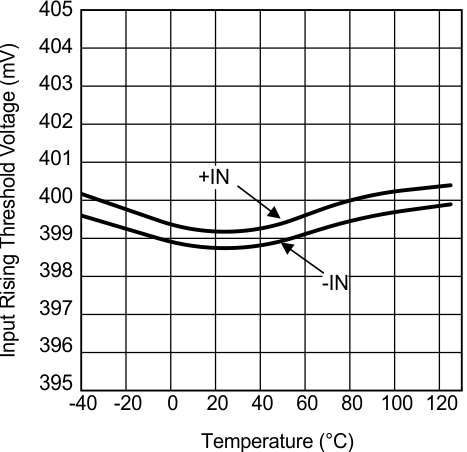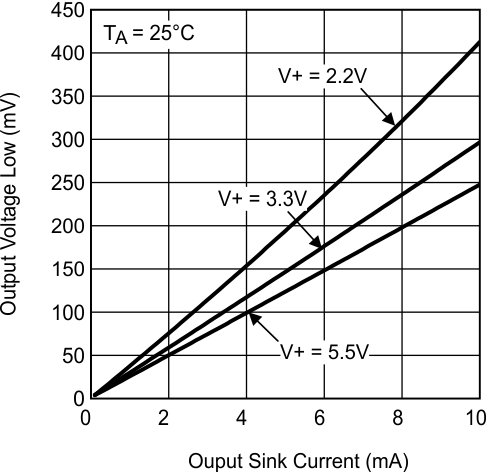SNOSB45F February 2010 – January 2016 LMV7231
PRODUCTION DATA.
- 1 Features
- 2 Applications
- 3 Description
- 4 Revision History
- 5 Pin Configuration and Functions
- 6 Specifications
- 7 Detailed Description
- 8 Application and Implementation
- 9 Power Supply Recommendations
- 10Layout
- 11Device and Documentation Support
- 12Mechanical, Packaging, and Orderable Information
パッケージ・オプション
メカニカル・データ(パッケージ|ピン)
- RTW|24
サーマルパッド・メカニカル・データ
- RTW|24
発注情報
6 Specifications
6.1 Absolute Maximum Ratings
See (1)(2)(3).| MIN | MAX | UNIT | |
|---|---|---|---|
| Supply voltage | 6 | V | |
| Voltage at input / output pin | GND − 0.3 | 6 | V |
| Output current | 10 | mA | |
| Total package current | 50 | mA | |
| Junction temperature(4) | 150 | °C | |
| Storage temperature, Tstg | –65 | 150 | °C |
(1) Stresses beyond those listed under Absolute Maximum Ratings may cause permanent damage to the device. These are stress ratings only, which do not imply functional operation of the device at these or any other conditions beyond those indicated under Recommended Operating Conditions. Exposure to absolute-maximum-rated conditions for extended periods may affect device reliability.
(2) If Military/Aerospace specified devices are required, contact the Texas Instruments Sales Office/Distributors for availability and specifications.
(3) For soldering specifications, see Absolute Maximum Ratings for Soldering (SNOA549).
(4) The maximum power dissipation is a function of TJ(MAX), RθJA. The maximum allowable power dissipation at any ambient temperature is PD = (TJ(MAX) – TA) / RθJA. All numbers apply for packages soldered directly onto a PCB.
6.2 ESD Ratings
| VALUE | UNIT | |||
|---|---|---|---|---|
| V(ESD) | Electrostatic discharge | Human body model (HBM), per ANSI/ESDA/JEDEC JS-001(1)(2) | ±2000 | V |
| Machine model | ±200 | |||
(1) JEDEC document JEP155 states that 500-V HBM allows safe manufacturing with a standard ESD control process.
(2) Human Body Model, applicable std. MIL-STD-883, Method 3015.7. Machine Model, applicable std. JESD22-A115-A (ESD MM std. of JEDEC) Field-Induced Charge-Device Model, applicable std. JESD22-C101-C (ESD FICDM std. of JEDEC).
6.3 Recommended Operating Conditions
| MIN | MAX | UNIT | ||
|---|---|---|---|---|
| Supply voltage | 2.2 | 5.5 | V | |
| Junction temperature(1) | –40 | 125 | °C | |
(1) The maximum power dissipation is a function of TJ(MAX), RθJA. The maximum allowable power dissipation at any ambient temperature is PD = (TJ(MAX) – TA) / RθJA. All numbers apply for packages soldered directly onto a PCB.
6.4 Thermal Information
| THERMAL METRIC(1) | LMV7231 | UNIT | |
|---|---|---|---|
| RTW (WQFN) | |||
| 24 PINS | |||
| RθJA | Junction-to-ambient thermal resistance | 37.4 | °C/W |
| RθJC(top) | Junction-to-case (top) thermal resistance | 40.2 | °C/W |
| RθJB | Junction-to-board thermal resistance | 16.1 | °C/W |
| ψJT | Junction-to-top characterization parameter | 0.6 | °C/W |
| ψJB | Junction-to-board characterization parameter | 16.2 | °C/W |
| RθJC(bot) | Junction-to-case (bottom) thermal resistance | 5.2 | °C/W |
(1) For more information about traditional and new thermal metrics, see the Semiconductor and IC Package Thermal Metrics application report, SPRA953.
6.5 3.3-V Electrical Characteristics
Unless otherwise specified, all limits ensured for TA = 25°C, V+ = 3.3 V ±10%, GND = 0 V, and RL > 1 MΩ.| PARAMETER | TEST CONDITION | MIN(1) | TYP(2) | MAX(1) | UNIT | ||
|---|---|---|---|---|---|---|---|
| VTHR | Threshold: input rising | RL = 10 kΩ | 394 | 400 | 406 | mV | |
| TA = –10°C to +70°C | 391.4 | 408.6 | |||||
| VTHF | Threshold: input falling | RL = 10 kΩ | 386 | 394 | 401 | mV | |
| TA = –10°C to +70°C | 383.8 | 403.2 | |||||
| VHYST | Hysteresis (VTHR − VTHF) | RL = 10 kΩ | 3.9 | 6.0 | 8.8 | mV | |
| IBIAS | Input bias current | VIN = V+, GND, and 5.5 V | –5 | 0.05 | 5 | nA | |
| TA = –10°C to +70°C | –15 | 15 | |||||
| VOL | Output low voltage | IL = 5 mA | 160 | 200 | mV | ||
| TA = –10°C to +70°C | 250 | ||||||
| IOFF | Output leakage current | VOUT = V+, 5.5 V and 40 mV of overdrive | 0.4 | μA | |||
| TA = –10°C to +70°C | 1 | ||||||
| tPDHL1 | High-to-low propagation delay (+IN falling) | 10 mV of overdrive | 2.6 | 6 | μs | ||
| tPDHL2 | High-to-low propagation delay (-IN rising) | 10 mV of overdrive | 5.4 | 10 | μs | ||
| tPDLH1 | Low-to-high propagation delay (+IN rising) | 10 mV of overdrive | 5.6 | 10 | μs | ||
| tPDLH2 | Low-to-high propagation delay (-IN falling) | 10 mV of overdrive | 2.8 | 6 | μs | ||
| tr | Output rise time | CL= 10 pF, RL= 10 kΩ | 0.5 | μs | |||
| tf | Output fall time | CL = 100 pF, RL = 10 kΩ | 0.25 | μs | |||
| TA = –10°C to +70°C | 0.3 | ||||||
| IIN(1) | Digital input logic 1 leakage current | 0.2 | μA | ||||
| TA = –10°C to +70°C | 1 | ||||||
| IIN(0) | Digital input logic 0 leakage current | 0.2 | μA | ||||
| TA = –10°C to +70°C | 1 | ||||||
| VIH | Digital input logic 1 voltage | TA = –10°C to +70°C | 0.7 × V+ | V | |||
| VIL | Digital input logic 0 voltage | TA = –10°C to +70°C | 0.3 × V+ | V | |||
| IS | Power supply current | No loading (outputs high) | 46 | 60 | μA | ||
| TA = –10°C to +70°C | 84 | ||||||
| VTHPSS | VTH power supply sensitivity(3) | V+ ramp rate = 1.1 ms V+ step = 2.5 V to 4.5 V |
400 | μV | |||
| V+ ramp rate = 1.1 ms V+ step = 4.5 V to 2.5 V |
–400 | μV | |||||
(1) Limits are 100% production tested at 25°C. Limits over the operating temperature range are specified through correlations using the Statistical Quality Control (SQC) method.
(2) Typical values represent the most likely parametric norm as determined at the time of characterization. Actual typical values may vary over time and also depends on the application and configuration. The typical values are not tested and are not ensured on shipped production material.
(3) VTH power supply sensitivity is defined as the temporary shift in the internal voltage reference due to a step on the V+ pin.
6.6 Typical Characteristics
V+ = 3.3 V and TA =25°C unless otherwise noted.





























